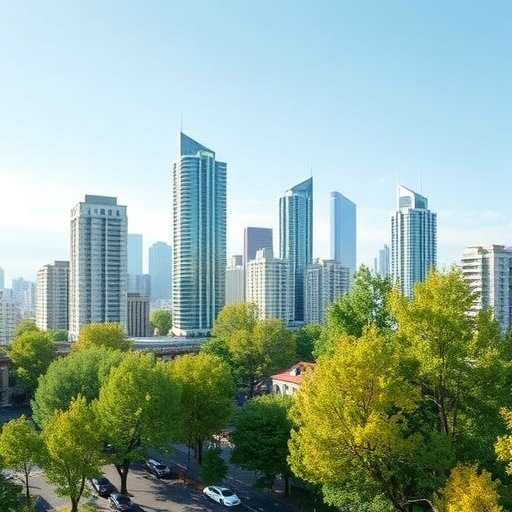In an era where urbanization is accelerating at an unprecedented pace, cities across the globe are confronting remarkable challenges that threaten the sustainability of their ecosystems and urban environments. Recent scholarly work delves into the relationship between city-level sustainability goals and the subsequent actions taken at the ground level, particularly regarding urban forestry practices. The research conducted by Bassett, Day, and Konijnendijk sheds light on the effectiveness of such sustainability ambitions in fostering actionable outcomes that benefit urban forestry. This exploration underscores not only the intentions behind the established sustainability targets but also the often complex dynamics that unfold in the implementation of these aspirations.
Urban forests play a critical role in enhancing urban biodiversity and improving the overall quality of life for city dwellers. They significantly contribute to the mitigation of urban heat islands, improve air quality, and provide green spaces that promote mental well-being. However, the gap between high-level sustainability goals and site-specific actions presents a challenge that needs addressing. The findings of this research illuminate how these adopted sustainability goals can both align and misalign with the realities faced by urban forestry practitioners.
The study investigates various case studies that represent a wide range of urban settings, from densely populated metropolises to more suburban areas. It methodically assesses how city planners, environmentalists, and local government officials interpret and implement sustainability targets. Through qualitative interviews and quantitative analyses, the authors map the convergences and divergences in the understanding of sustainability across different urban contexts. These insights offer a revealing look at how intentions can sometimes dilute in action due to political, social, and economic pressures.
Furthermore, the researchers scrutinize the role of public engagement and community involvement in achieving sustainability goals. Urban forestry isn’t merely a technical endeavor; it requires the active participation of community members to thrive. When cities engage residents in tree planting and maintenance initiatives, the likelihood of successful implementation and sustained commitment to sustainability goals increases markedly. The study highlights several successful examples where citizen partnerships have invigorated urban forestry programs, demonstrating the value of grassroots movements in bridging the divide between policy and practice.
Despite these opportunities, challenges persist. The research identifies several common barriers to effective execution of sustainability initiatives, such as funding limitations, bureaucratic red tape, and inconsistent policy frameworks. These obstacles are not merely administrative; they reflect a deeper philosophical quandary about prioritization in urban planning. For instance, are trees and green spaces deemed a priority in the face of pressing issues like housing shortages and transportation infrastructure? Such questions are vital to discern the trajectory of future urban forestry efforts.
Moreover, the article provides a critical analysis of how socio-economic factors influence urban forestry strategies. Often, low-income neighborhoods receive less investment in green space compared to wealthier areas, raising concerns about environmental justice. The research posits that a more equitable approach to urban forestry could help balance the scales, thereby enhancing not only ecological outcomes but also social equity. The implications of this study extend beyond theoretical discussions; they provoke critical dialogue about the inherent values that shape urban environments.
As cities adopt increasingly ambitious sustainability goals, the implications for urban forestry are profound. The expectation that practitioners can adhere to these targets without adequate resources or support is unrealistic. Thus, the findings advocate for revisiting the frameworks through which sustainability goals are created and enforced. It is essential for urban forestry initiatives to be both aspirational and attainable, ensuring that urban planners design policies that empower local communities and foster collaboration with environmental organizations.
Notably, the assessment of site-level actions provides invaluable insights into the performance of urban forestry initiatives in various locales. The authors identified best practices and innovative strategies that have proven successful in enhancing urban greening efforts. They encourage other cities to consider these as models that can be tailored to fit specific local contexts while remaining rooted in broader sustainability objectives.
A significant revelation from this research is that cities that actively monitor and evaluate their forestry programs tend to experience greater success in achieving their sustainability goals. Ongoing evaluation mechanisms allow for the adaptation and modification of strategies to meet emerging challenges and opportunities. This dynamic approach fosters resilience within urban forestry programs and ensures that they can evolve in response to changing environmental conditions and societal needs.
In conclusion, the study by Bassett and colleagues serves as a compelling reminder of the intricate interplay between policy and practice in urban forestry. By examining how city-level sustainability goals translate to site-level actions, it reframes the narrative around urban green initiatives. This research not only challenges urban planners and policy makers to align their actions with their intentions but also to craft deeper, more meaningful engagement with the communities they serve.
With the world moving towards more sustainable urban environments, the outcomes of this exploration force a reassessment of how we envision the role of trees and urban ecosystems in our cities. As more urban populations face the dual threats of climate change and biodiversity loss, effective urban forestry will undoubtedly be at the forefront of crafting greener, more resilient cities for future generations.
Urban residents, policymakers, and environmental advocates must work in tandem to ensure that the forestry initiatives not only preserve but also enhance the livability of our urban spaces. As the study shows, the best-laid plans require more than just ambition; they necessitate collaboration, resources, and unwavering commitment to bring the vision of sustainable cities to fruition.
Subject of Research: Influence of city sustainability goals on urban forestry actions.
Article Title: The best laid plans: How do adopted city sustainability goals influence site-level action in urban forestry?
Article References:
Bassett, C.G., Day, S.D., Konijnendijk, C.C. et al. The best laid plans: How do adopted city sustainability goals influence site-level action in urban forestry?.
Ambio (2025). https://doi.org/10.1007/s13280-025-02247-0
Image Credits: AI Generated
DOI: 10.1007/s13280-025-02247-0
Keywords: Urban forestry, sustainability goals, community engagement, environmental justice, urban ecosystems.




